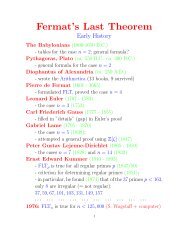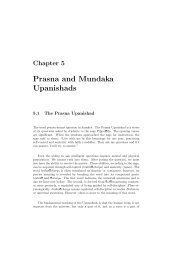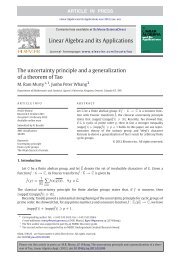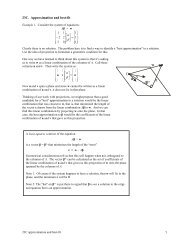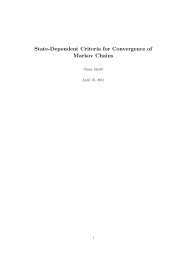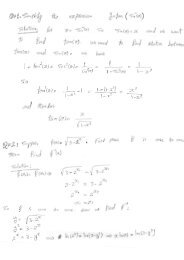Lecture Notes - Department of Mathematics and Statistics - Queen's ...
Lecture Notes - Department of Mathematics and Statistics - Queen's ...
Lecture Notes - Department of Mathematics and Statistics - Queen's ...
Create successful ePaper yourself
Turn your PDF publications into a flip-book with our unique Google optimized e-Paper software.
28 CHAPTER 3. CLASSIFICATION OF MARKOV CHAINS<br />
Likewise,<br />
∫<br />
〈µ T , Pf〉 :=<br />
∫<br />
µ T (dx)(<br />
P(dy|x)f(y)) → 〈µ ∗ , Pf〉.<br />
Now,<br />
(µ T − µ T P)(f) = 1 ( T∑ −1<br />
T E µ 0<br />
Px k f −<br />
k=0<br />
T∑<br />
−1<br />
k=0<br />
)<br />
Px<br />
k+1 f<br />
= 1 )<br />
T E µ 0<br />
(f(x 0 ) − f(x T ) → 0. (3.15)<br />
Thus,<br />
(µ T − µ T P)(f) = 〈µ T , f〉 − 〈µ T P, f〉 = 〈µ T , f〉 − 〈µ T , Pf〉 → 〈µ ∗ − µ ∗ P, f〉 = 0.<br />
Thus, µ ∗ is an invariant probability measure.<br />
⊓⊔<br />
Lasserre [19] gives the following example to emphasize the importance <strong>of</strong> the Feller property: Consider a Markov<br />
chain evolving in [0, 1] given by: P(x, x/2) = 1 for all x ≠ 0 <strong>and</strong> P(0, 1) = 1. This chain does not admit an<br />
invariant measure.<br />
Remark 3.4.1 Lasserre presents a class <strong>of</strong> chains, Quasi-Feller chains, which are weak Feller except on a closed<br />
set <strong>of</strong> points N such that P(x, N) = 0 for all x ∈ D = X \ N, P(x, N) < 1 for x ∈ N, <strong>and</strong> for all x ∈ D, the<br />
chain is weak Feller.<br />
3.4.2 Case without the Feller condition<br />
One can also relax the weak Feller condition.<br />
Theorem 3.4.2 [20] For a Markov chain, under a uniform countable additivity condition as in (4.7) in the next<br />
chapter, there exists an invariant probability measure if <strong>and</strong> only if there exists a non-negative function g with<br />
lim<br />
n→∞<br />
inf g(x) = ∞<br />
x/∈K n<br />
<strong>and</strong> an initial probability measure ν 0 such that sup t E ν0 [g(x t )] < ∞.<br />
The pro<strong>of</strong> <strong>of</strong> this result follows from a similar observation as (3.15) but with weak convergence replaced by<br />
setwise convergence:<br />
Lemma 3.4.3 [7, Thm. 4.7.25] Let µ be a finite measure on a measurable space (T, A). Assume a set <strong>of</strong><br />
probability measures Ψ ⊂ P(T) satisfies<br />
Then Ψ is setwise precompact.<br />
P ≤ µ, for all P ∈ Ψ.<br />
A sequence <strong>of</strong> occupation measures under (4.7) has a subsequence which converges setwise <strong>and</strong> the limit <strong>of</strong> this<br />
subsequence is invariant. As an example, consider a system <strong>of</strong> the form:<br />
x t+1 = f(x t ) + w t (3.16)<br />
where w t admits a distribution with a bounded density function, which is positive everywhere. If the system has<br />
a finite second moment, then, the system admits an invariant probability measure which is unique.



